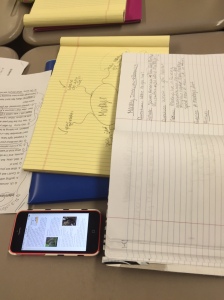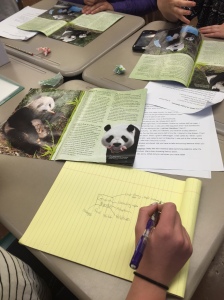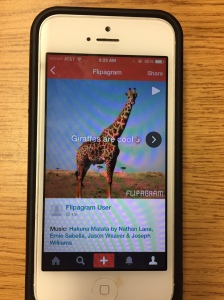The Monday morning after Ralph Fletcher’s presentation on Authentic Information Writing at Vassar College, I gathered my sixth graders at our reading area and shared what I had heard and learned, then we read Fletcher’s “Interview With a Coho Salmon”: an information article about the life cycle of this type of salmon written in an interview format, replete with corny jokes and lots of information:
My kids groaned and laughed at the puns and jokes, but there was also plenty of “Woah! I didn’t know that!” and “Huh, that’s so cool to know.” Finally, they wanted to know: “Can we write something like this – it would be SO much fun!”
Music to this writing teacher’s ears.
So, I offered the following guidelines for our new mini-unit of study – The Information Interview:
* choose a partner to collaborate with (it would be ideal to work in groups of two, but our class size is, of course, an uneven number)
* decide on a specific topic of mutual interest (it could be one you researched and wrote about for our just completed Feature Articles)
* create a web or box and bullet the points you wish to cover in your interview
* frame those points as questions and create a logical flow for those questions – be sure to include at least one follow up question
* frame responses to those questions – include definitions, statistics, surprising information, facts…and jokes/puns
have fun!
I was amazed at how quickly my students sorted themselves out in terms of partners to collaborate with and topics they wanted to write about. They got to work quickly, using research materials in our classrooms and as well as their phones (our school laptops had been commandeered for the last round of PARCC testing). It was obvious to see that they were eager to get going! I also shared the following suggestions from Ralph Fletcher:
* generate questions, wonderings, speculations
* make a map or web of your topic
* collect surprising information, facts, statistics
* react: what amazes/appalls you about the topic?
* make a prediction
* build a lexicon or glossary of words or terms specific to the subject
draw or sketch
*sift, sort, summarize
*try a “flash draft” on the topic
By Friday, my students had finalized their interviews and begun working on the their video introductions to their presentations – a set of photographs or a video to activate prior knowledge for their classmates. Here, for example, is a Flipagram two students created for their introductions:
So, what was our take away after a week working with the Information Interview? Here’s what my students had to say:
* this was so much more fun to write because we could be creative
* we could let our personalities come through – especially with the puns and jokes
* talking with another person about the topic really helped figure out how to include interesting information
* we loved figuring out fun ways to include facts and important information
* when I wrote my feature article, I kind of lost my interest in the topic by the time I’d finished, but this way of writing just kept me interested all the way through
* I liked that we could create our own structure – we could figure out how to say what we wanted to say
** can we do this again?
In his presentation, Ralph had challenged us to encourage our students to try “Type B writing”: writing that is exploratory, and allows kids to experiment and practice with writing moves and forms. Best of all, he had given us a writing option which values passion, originality and voice – the elements that form the very heart of the mission of writing workshop.






Yesterday i read my students’ informational drafts on colonial times and ugh… The classic “did you ever wonder… and I hope you liked… permeated their writing. This was the antidote! I had a student sit with me and read the text aloud with me. So fun and re-energizing. Blessings on you for this piece. It saved me (and more importantly my students) from a pain-filled informational writing cycle. And in case you missed, check out this post from Pernille Ripp: http://pernillesripp.com/2015/05/11/in-which-we-change-the-way-we-write/
LikeLike
If you google “Interview With a Coho Salmon” you can find it. Duh!!
🙂
Look forward to implementing some of these ideas in my lessons. Thanks for sharing!
LikeLike
I would love to try this…is there a place we can access the interview you showed your class? Thanks!
LikeLike
What a great idea that I am tucking away for the future. I am going to be in the classroom next year and posts like yours make me even more excited to get back. I love the concept of Type B writing. Thanks for sharing your process.
LikeLike
I am also really excited by the possibilities presented here! I know my third graders love learning true facts and we are preparing to do some animal research. I think modeling an information interview will be a fun way for them to share their facts while incorporating some voice and humor! Thanks for sharing your students excitement. You clearly do AMAZING work!
LikeLike
What a wonderful and informative post. Thank you for sharing what you learned and how you applied what you learned. I used to teach a similar unit with my English Language Learners but I did it a bit differently. I used a graphic organizer, got the kids to write down questions they had, what they learned and what they were wondering. Then they selected their favorite of each category and wrote what I called nonfiction poems which were published in a class anthology. This approach, applied to almost any content area, always produced incredible results. As was the case with your students, they loved the opportunity to research their info in a different way and restructure it in a more imaginative format. Kudos to you and your students!
LikeLike
Love, love, love it!!! We are in the 1960s this last six weeks, and we are about half-way through The Watsons go to Birmingham. This is our unit to research, and I give them free choice of topic…we’ve been building background knowledge all during our reading. Seeing that we will begin packing up our campus to move OUT the day after students finish, it is slim pickings for computer time. I love the creativity and opportunity this presents! I hope to see Ralph in June in Texas. Thanks for sharing, and how might I get a copy of the Salmon?
LikeLike
Looks and sounds so much like FUN as well! Thanks for both posts, Tara, so we could get Ralph’s advice as well as how this worked “through” your students’ voices!
LikeLike
I can hear the enthusiasm in your post. We are too near the end of year (and another week of testing) to consider another project, but I want to tuck this away for next year.
LikeLike
Holy Cow, that was a great post. I know my second graders would love to do this too. I need to figure out how to save all the great ideas I read about in one findable resource. I love how seamlessly you allowed them to integrate technology in very real ways.
LikeLike
“Music to a writing teacher’s ears…..,” that’s for sure. What a wonderful example of writing for a purpose with a mentor text that kids want to use!
LikeLike